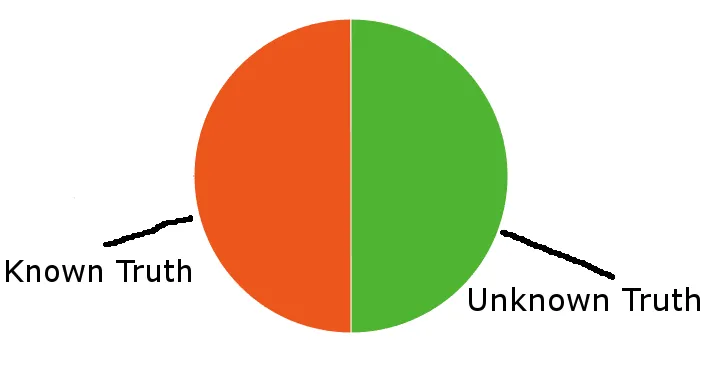
I was discussing with someone the other day why two people (or more) can both be telling the truth and both think the other is not. I was trying to explain how this works and I thought perhaps it would be better to make a post about it. I write a lot about perspective and trying to see more of the truth than what I believe a lot, so I thought perhaps this could help others. The thing about truth is that it is actually subjective. Truth and facts are not the same thing. Disagreements about truth and lies are not the same thing. Just because you don't agree with someone or think they are a liar doesn't actually make them so and I'll show you how I view truth visually and perhaps this could help some users out there. If you have heard via the news that we are in the "post truth" era, perhaps it's actually more correct than you think.

Every individual has what they know to be true and what they don't know to be true. Just because they know something to be true, doesn't automatically make what they don't know to be true a known untruth. For example, Bob likes apples. You know Bob like's apples and I know for a fact that Bob doesn't like apples. We are both in our own minds telling the other person something we both know to be true. Adding perspective and context would explain why this is the case. You know that Bob like's red apples because you see him eat them regularly. I on the other hand offered Bob a green apple multiple times and he always declined and made a disgusted face at my apple. We both know part of the truth and not the whole truth.

This problem compounds exponentially when you add in other factors. Let's say we have three individuals all with some truth about the knowledge of Bob's like or dislike for apples. All of these truths are varying pieces to a large puzzle that make up the whole truth about Bob's apple appetite. There is more to it still though, what if one of the individuals with a perspective of truth is also colorblind and one hasn't spoken to Bob since he was a child. This is where synchronicity comes into play. At different points and time things are more or less true than at other times. Perhaps Bob didn't like apples as a child or due to one's color blindness the actual color of the apple was mistaken. Bob's tastes change over time. There are countless variables that make up the whole truth and assuming we know the whole truth because we know our truth does not make us more right or wrong than another.

The easiest way I could sum it up would be that the pie chart I showed is actually a sphere. The sphere encompasses everyone and everything that could have ever interacted with Bob and have a piece of the puzzle as to his particular tastes or desires related to apples. Those segments are also of different density because they are more or less relevant due to synchronicity. I wouldn't ask someone from 20 years ago that doesn't even remember who Bob is about the type of apple he saw Bob eat, but that doesn't mean that it isn't a possible source of information. I also wouldn't ask someone that is going to meet Bob next week at the grocery store what type of Apple he thinks Bob will purchase because it doesn't take into account numerous factors plus it hasn't technically happened yet for that individual. Who knows, perhaps Bob dies before ever getting to the store to buy that apple and someone that never meets Bob now has an opinion about his apple preference. The point of all of this is that just because you know something to be true and perceive it as conflicting with what someone else knows to be true doesn't automatically make you right.
You notice how truth in this case is also not coming from the only source that is relevant at the exact space and time we need to know? If Bob isn't the one telling you his truth, your truth about Bob can never be close to the whole truth. Perspective. Namaste.